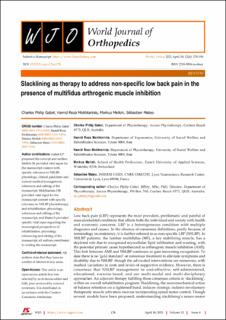Please use this identifier to cite or link to this item:
https://doi.org/10.21256/zhaw-25895| Publication type: | Article in scientific journal |
| Type of review: | Peer review (publication) |
| Title: | Slacklining as therapy to address non-specific low back pain in the presence of multifidus arthrogenic muscle inhibition |
| Authors: | Gabel, Charles Philip Mokhtarinia, Hamid Reza Melloh, Markus Mateo, Sébastien |
| et. al: | No |
| DOI: | 10.5312/wjo.v12.i4.178 10.21256/zhaw-25895 |
| Published in: | World Journal of Orthopedics |
| Volume(Issue): | 12 |
| Issue: | 4 |
| Page(s): | 178 |
| Pages to: | 196 |
| Issue Date: | 2021 |
| Publisher / Ed. Institution: | Beijing Baishideng BioMed Scientific |
| ISSN: | 2218-5836 |
| Language: | English |
| Subjects: | Arthrogenic muscle inhibition; Hypothesis; Low back pain; Multifidus; Slacklining; Therapy-intervention |
| Subject (DDC): | 615: Pharmacology and therapeutics 617.5: Orthopaedic surgery |
| Abstract: | Low back pain (LBP) represents the most prevalent, problematic and painful of musculoskeletal conditions that affects both the individual and society with health and economic concerns. LBP is a heterogeneous condition with multiple diagnoses and causes. In the absence of consensus definitions, partly because of terminology inconsistency, it is further referred to as non-specific LBP (NSLBP). In NSLBP patients, the lumbar multifidus (MF), a key stabilizing muscle, has a depleted role due to recognized myocellular lipid infiltration and wasting, with the potential primary cause hypothesized as arthrogenic muscle inhibition (AMI). This link between AMI and NSLBP continues to gain increasing recognition. To date there is no 'gold standard' or consensus treatment to alleviate symptoms and disability due to NSLBP, though the advocated interventions are numerous, with marked variations in costs and levels of supportive evidence. However, there is consensus that NSLBP management be cost-effective, self-administered, educational, exercise-based, and use multi-modal and multi-disciplinary approaches. An adjuvant therapy fulfilling these consensus criteria is 'slacklining', within an overall rehabilitation program. Slacklining, the neuromechanical action of balance retention on a tightened band, induces strategic indirect-involuntary therapeutic muscle activation exercise incorporating spinal motor control. Though several models have been proposed, understanding slacklining's neuro-motor mechanism of action remains incomplete. Slacklining has demonstrated clinical effects to overcome AMI in peripheral joints, particularly the knee, and is reported in clinical case-studies as showing promising results in reducing NSLBP related to MF deficiency induced through AMI (MF-AMI). Therefore, this paper aims to: rationalize why and how adjuvant, slacklining therapeutic exercise may positively affect patients with NSLBP, due to MF-AMI induced depletion of spinal stabilization; considers current understandings and interventions for NSLBP, including the contributing role of MF-AMI; and details the reasons why slacklining could be considered as a potential adjuvant intervention for NSLBP through its indirect-involuntary action. This action is hypothesized to occur through an over-ride or inhibition of central down-regulatory induced muscle insufficiency, present due to AMI. This subsequently allows neuroplasticity, normal neuro-motor sequencing and muscle re-activation, which facilitates innate advantageous spinal stabilization. This in-turn addresses and reduces NSLBP, its concurrent symptoms and functional disability. This process is hypothesized to occur through four neuro-physiological processing pathways: finite neural delay; movement-control phenotypes; inhibition of action and the innate primordial imperative; and accentuated corticospinal drive. Further research is recommended to investigate these hypotheses and the effect of slacklining as an adjuvant therapy in cohort and control studies of NSLBP populations. |
| URI: | https://digitalcollection.zhaw.ch/handle/11475/25895 |
| Fulltext version: | Published version |
| License (according to publishing contract): | CC BY-NC 4.0: Attribution - Non commercial 4.0 International |
| Departement: | School of Health Sciences |
| Appears in collections: | Publikationen Gesundheit |
Files in This Item:
| File | Description | Size | Format | |
|---|---|---|---|---|
| 2021_Gabel-etal_Slacklining-therapy-address-non-specific-low-back-pain.pdf | 596.18 kB | Adobe PDF |  View/Open |
Show full item record
Gabel, C. P., Mokhtarinia, H. R., Melloh, M., & Mateo, S. (2021). Slacklining as therapy to address non-specific low back pain in the presence of multifidus arthrogenic muscle inhibition. World Journal of Orthopedics, 12(4), 178–196. https://doi.org/10.5312/wjo.v12.i4.178
Gabel, C.P. et al. (2021) ‘Slacklining as therapy to address non-specific low back pain in the presence of multifidus arthrogenic muscle inhibition’, World Journal of Orthopedics, 12(4), pp. 178–196. Available at: https://doi.org/10.5312/wjo.v12.i4.178.
C. P. Gabel, H. R. Mokhtarinia, M. Melloh, and S. Mateo, “Slacklining as therapy to address non-specific low back pain in the presence of multifidus arthrogenic muscle inhibition,” World Journal of Orthopedics, vol. 12, no. 4, pp. 178–196, 2021, doi: 10.5312/wjo.v12.i4.178.
GABEL, Charles Philip, Hamid Reza MOKHTARINIA, Markus MELLOH und Sébastien MATEO, 2021. Slacklining as therapy to address non-specific low back pain in the presence of multifidus arthrogenic muscle inhibition. World Journal of Orthopedics. 2021. Bd. 12, Nr. 4, S. 178–196. DOI 10.5312/wjo.v12.i4.178
Gabel, Charles Philip, Hamid Reza Mokhtarinia, Markus Melloh, and Sébastien Mateo. 2021. “Slacklining as Therapy to Address Non-Specific Low Back Pain in the Presence of Multifidus Arthrogenic Muscle Inhibition.” World Journal of Orthopedics 12 (4): 178–96. https://doi.org/10.5312/wjo.v12.i4.178.
Gabel, Charles Philip, et al. “Slacklining as Therapy to Address Non-Specific Low Back Pain in the Presence of Multifidus Arthrogenic Muscle Inhibition.” World Journal of Orthopedics, vol. 12, no. 4, 2021, pp. 178–96, https://doi.org/10.5312/wjo.v12.i4.178.
Items in DSpace are protected by copyright, with all rights reserved, unless otherwise indicated.